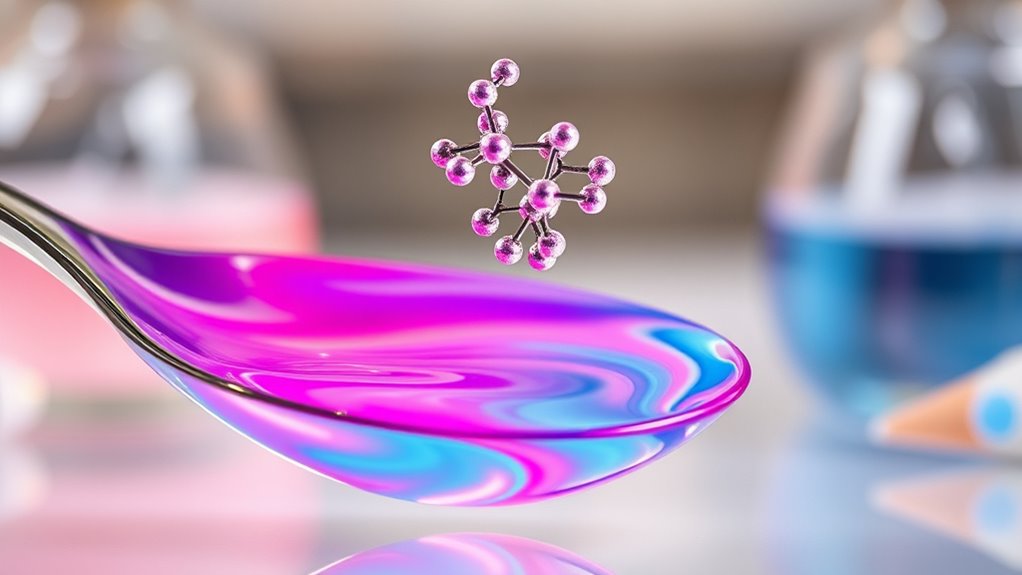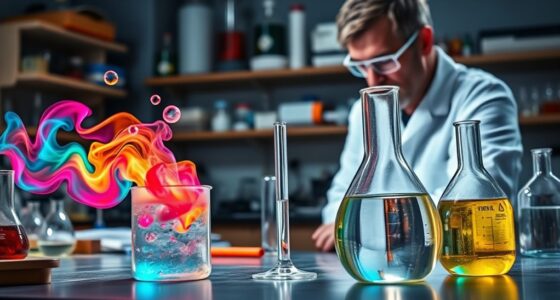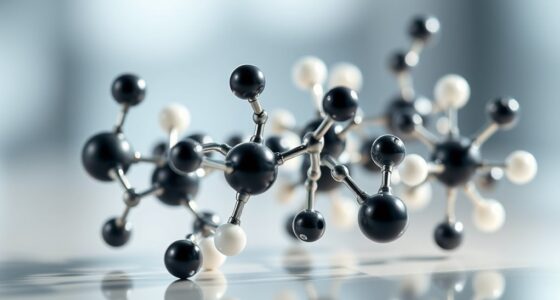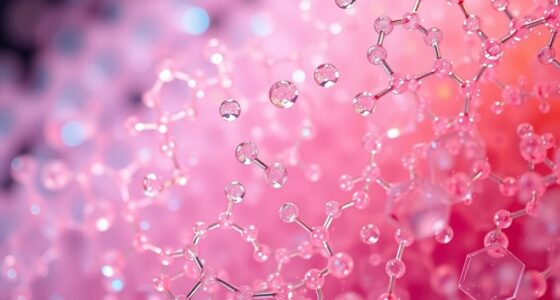Chirality means molecules have mirror-image forms called enantiomers, which can affect how you perceive taste and smell. These mirror molecules interact differently with your sensory receptors, causing distinct flavors or aromas even though they have the same chemical makeup. For example, one enantiomer of a scent might smell pleasant, while its mirror image might not. Understanding how these molecules work can reveal why our senses react so differently to similar substances; if you continue exploring, you’ll uncover fascinating details about everyday flavors and fragrances.
Key Takeaways
- Enantiomers are mirror-image molecules whose different shapes cause distinct interactions with sensory receptors.
- Chirality influences how molecules bind to taste and smell receptors, leading to different sensory perceptions.
- Even identical chemical formulas can smell or taste different due to their chiral configurations.
- Recognizing chiral differences improves flavorings, fragrances, and sensory experiences in daily life.
- Chirality plays a crucial role in pharmaceuticals, where enantiomers can have vastly different effects on health.

Chirality is a fascinating aspect of the world around us that often goes unnoticed, yet it plays an essential role in everyday life. You mightn’t realize it, but many of the substances you encounter daily are chiral molecules, meaning they’ve mirror-image forms called enantiomers. These enantiomers can have dramatically different effects, especially when it comes to taste, smell, and even medical applications.
For example, your sense of taste can be influenced by the chirality of molecules in food or medicine. This is because our bodies often react differently to each enantiomer, which is why scientists pay close attention to chirality during processes like enantioselective reactions and chiral drug synthesis. In these processes, chemists aim to produce or separate specific enantiomers to guarantee desired effects and minimal side effects.
When you think about chiral drug synthesis, it becomes clear how essential chirality is to medicine. Many drugs are chiral, and their effectiveness can depend on which enantiomer is present. For instance, one enantiomer might provide the therapeutic benefit, while the other could be inactive or even harmful.
To address this, researchers develop enantioselective reactions that allow them to selectively produce the beneficial enantiomer, improving drug safety and efficacy. This precision reduces the risk of adverse reactions and guarantees that patients receive the most effective medication. The importance of enantioselective reactions extends beyond pharmaceuticals; they’re also fundamental in producing flavorings, fragrances, and other compounds where the sensory properties depend on chirality.
Your sense of smell is also affected by molecular chirality. Some molecules, such as certain aromatic compounds, have enantiomers that smell distinctly different—even though they share the same chemical formula. This difference arises because the enantiomers interact differently with the chiral receptors in your nose.
Similarly, in taste, the chirality of molecules like amino acids can alter flavor perception. These subtle differences highlight why producing specific enantiomers through chiral drug synthesis or enantioselective reactions is so important in designing compounds with desired sensory or therapeutic properties.
Additionally, advancements in understanding chiral recognition have led to the development of more precise analytical techniques for identifying and separating enantiomers, further enhancing our ability to harness chirality in various fields. Recognizing the impact of molecular structure on sensory experiences is crucial for developing new products and medicines that are both effective and safe.
Frequently Asked Questions
How Does Chirality Affect Drug Effectiveness and Safety?
You should know that chirality greatly impacts drug effectiveness and safety. When drugs have high enantiomeric purity, they work better and reduce side effects.
Chirality influences pharmacokinetics, affecting how your body absorbs, distributes, metabolizes, and excretes medications. If a drug contains unwanted mirror images, it might be less effective or even cause adverse reactions.
Ensuring the right enantiomeric form makes treatments safer and more efficient for you.
Can Mirror Molecules Influence Emotional Responses?
You mightn’t realize it, but mirror molecules can influence your emotional perception through mirror effects. When you encounter these chiral molecules, your brain interprets their structures differently, which can subtly alter your emotional responses.
For example, the aroma of certain scents or flavors can evoke specific feelings because of their mirror images. So, yes, mirror molecules do play a role in shaping how you emotionally perceive the world around you.
Are There Natural Sources of Chiral Compounds in the Environment?
You’ll find natural sources of chiral compounds all around you in the environment. Plants produce these compounds in their essential oils, fruits, and vegetables, while microorganisms create chiral molecules as part of their metabolic processes.
Environmental compounds like pollen and certain minerals also contain chiral molecules. These natural sources influence various biological and chemical processes, affecting everything from plant interactions to human sensory experiences.
How Is Chirality Used in the Food Industry for Flavor Enhancement?
Think of a secret recipe where every ingredient matters. In the food industry, chirality plays a key role in taste modification and flavor enhancement.
By selecting specific enantiomers, you can intensify or mellow flavors, making products more appealing. Chefs and scientists use chiral molecules to craft precise taste profiles, ensuring each bite delights the senses.
This subtle manipulation of mirror molecules transforms ordinary foods into extraordinary culinary experiences.
Can Artificial Chirality Be Created Easily in Laboratories?
You can create artificial chirality in labs fairly easily using enantioselective synthesis, which selectively produces one mirror-image form of a molecule.
Chiral catalysts play a key role here, speeding up reactions to generate specific enantiomers efficiently.
While it requires specialized techniques and equipment, modern chemistry has made it quite accessible for researchers to produce chiral compounds consistently, enabling advances in pharmaceuticals, flavors, and fragrances.
Conclusion
Just like your reflection in a mirror, molecules can have a mirrored life that changes how you taste and smell. Chirality is the secret behind why some flavors and scents seem to flip when you look at them differently. Understanding this invisible dance helps you see the world in a new light—where tiny molecular twists can turn everyday experiences into fascinating mysteries. So next time you smell or taste something, remember, it’s all about the mirror image playing tricks behind the scenes.









